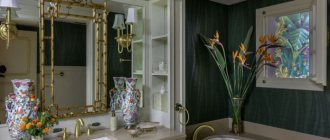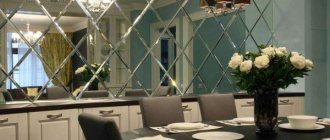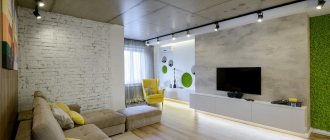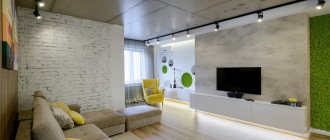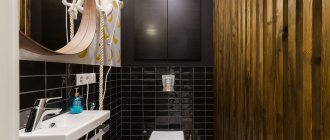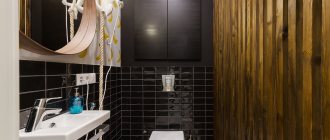Description, operating principle, fuel
What is a biofireplace?
A biofireplace is a modern and safe interpretation of a fireplace without a chimney, which can be used in almost any room, which is undoubtedly an advantage.
How does it work? The biofireplace runs on biofuel, which consists of biological raw materials, and the combustion products are no more harmful than those from a paraffin candle. Externally, a biofireplace can resemble the classic version or be a modern design that will decorate a fashionable interior.
The photo shows a stylish living room combined with a dining area. A double-sided fireplace not only performs a decorative function, but also helps to zone the space of the apartment.
Operating principle
The principle of operation is quite simple. Fuel is poured into the fuel tank and ignited with a lighter. To get fire, these two actions are quite enough. For safety and slow evaporation of fuel, ceramic wool is used.
Fuel for biofireplace
The fuel is technical alcohol. The consistency can be different, for example gel or liquid. To obtain biogel, alcohol, water, thickener and salt are added to the composition. The liquid form of fuel is obtained by processing agricultural crops.
Fuel consumption is quite economical, on average 0.5 liters per hour and a half of operation. But consumption may vary depending on the features of the selected model. The combustion temperature of the flame itself depends on the selected fuel, on average it is 400-600 degrees.
Does the bio-fireplace heat, heat transfer?
Biofireplaces, in addition to aesthetic pleasure, also provide warmth. The heat output of different models differs, starting from 1 kW and can reach 10 kW. In terms of heat production, a biofireplace can be compared to an electric heater. Small fireplaces most often do not have a heating function.
Do you need an outlet?
There is no need for electricity to operate. A natural flame is formed during the combustion of fuel.
Requirements for the room in which the biofireplace is installed
The biofireplace does not have any special requirements for placement, however, basic precautions must still be observed.
- The room in which the bio-fireplace is installed should be well ventilated, but not have strong drafts, just like fans and air conditioners.
- The distance from any interior items should be at least a meter, and from flammable objects such as paper or textiles, at least one and a half meters.
The photo shows a minimalist living room decorated in black and white and a long bio-fireplace.
Traditional, automatic and semi-automatic
The difference between traditional, automatic and semi-automatic biofireplaces is in control technology.
- A traditional, or in other words, mechanical fireplace is lit manually, using matches or a lighter.
- The automatic fireplace is controlled remotely by phone, tablet or remote control.
- The semi-automatic model begins and ends its work after a command given through the control panel located on the fireplace itself.
Open and closed
The difference between open and closed type is in the design of the fuel tank. The open type allows you to see the amount of liquid inside, while the closed type “hides” the firebox inside the structure box.
Functions
The biofireplace successfully copes with a number of functions. The first and most important thing is, of course, heating. It heats rooms up to 50 m² well. The next function is decorative. A variety of design solutions allows you to choose a fireplace that suits any interior style. In addition, it is great for filling a room with vapors of aromatic oils, which not only smell pleasant, but also have a beneficial effect on a person’s general condition.
The fuel used in biofireplaces is very environmentally friendly, because... it is constantly renewed. During its combustion, carbon dioxide is released. Its amount is exactly the same as that which is absorbed by plants to produce biomass.
You can read more about the features of fuel types for biofireplaces here.
Design
How is the fireplace constructed? The design of the case can be almost anything, depending on personal preferences. The main requirement is compliance with safety rules, or rather the required minimum distance from the flame. The top of the flame should be at least 80 cm from the surface of the body, and the distance from the side should be at least 20-25 cm.
Requirements for the premises when installing a fireplace and operating rules
Although biofireplaces are not connected to the hood, which is convenient for city apartments, it is necessary to ventilate the room where they are installed. For rooms whose area exceeds 20-25 square meters, natural air exchange through open windows is sufficient. In small rooms, man-made ventilation is needed for regular air circulation, as carbon dioxide will accumulate in dangerous concentrations. Its excess negatively affects the human body and can lead to health problems. A pleasant and necessary addition would be to decorate the room with indoor plants in pots, which will “distill” it into oxygen.
When lighting a fireplace, the fuel may emit a specific “alcohol” odor, which dissipates very quickly. To avoid this, add a couple of drops of aromatic oil to the tank, which “will not spoil the porridge.”
Types and diagrams of burners
As for the description of the burners, they can be of several types and have different characteristics, but they all operate on the general principle, evaporative atmospheric. That is, the fuel evaporates in a heated chamber in the absence of air, and the vapors released into the atmosphere burn in the air.
For this operating principle, there are three types of burners:
- capillary,
- wick,
- gravity flow.
The capillary burner has a simple design, but there are a number of disadvantages. When starting up, you may smell ethanol; the filler in the burner tank becomes clogged over time and requires replacement, and it is also necessary to provide a barrier and adjust the flame height, since at the beginning of operation the fire burns hotter.
The wick burner is easier to use. Filling the container with fuel is done “by eye”. The flame of this type of burner is stable, without sudden changes, so a barrier is not required, except for various flame effects, but it is worth providing for the presence of a divider grille.
A gravity burner produces a stable flame during operation and does not emit vapors when warming up, since a supply of them is formed in the evaporator and this is enough to start. In addition, this type of burner can be produced in a round shape, provides long operation, up to 4 hours, and is also suitable for a fireplace of any power.
Advantages and disadvantages
A biofireplace, like any other device, has its advantages and disadvantages. It is worth noting the most significant of them.
Pros:
- The biofireplace is easy to install and operate;
- In addition to its decorative function in the interior, a biofireplace is an additional source of heat;
- Economical fuel consumption and low cost;
- Wide selection of models;
- Combustion products are not harmful to health.
Minuses:
- High cost, especially on models with automatic control;
- Open fire requires careful handling.
The photo shows a spacious living room in high-tech style. A freestanding floor-standing fireplace replaces the coffee table, and the flames can be seen from anywhere in the room.
Kinds
Tabletop (portable)
Mobile design that can be easily moved to another room. This model produces a minimum of heat and has more of a decorative function in the interior of the room. Mini biofireplaces operate on replaceable cartridges.
Built into a niche in the wall
An interesting model can be built into one or two vertical planes, that is, a corner biofireplace. Visually, the structure looks like part of a wall.
The photo shows the interior of a cozy living room in white and gray. A rectangular bio-fireplace built into the wall fills the room with warmth.
Built into furniture
A fireplace built into the furniture takes up little space, but creates a feeling of coziness in the interior. A mini bio-fireplace can be built into a coffee table. As a rule, it is installed on a flat horizontal surface. The table is easy to move and will give uniqueness to the interior. Another design option is a fireplace built into the countertop or central part of the cabinet.
The photo shows the interior of a bright living room in a modern style. The bio-fireplace is built into the chest of drawers, the back wall of which is decorated with mirror inserts.
Wall
The narrow design does not take up much space and, depending on the design, will decorate the interior in a modern style. The wall-mounted model is fixed to the wall with 2 screws.
Floor
A biofireplace of this type can be considered not part of the interior design, but its main object. Unlike wall-mounted and built-in models, a floor-mounted biofireplace provides a full view of the hearth from any side. Floor-standing models are heavier, but just as portable.
Suspension
The bio-fireplace is attached to the ceiling. This model will look good in rooms with high ceilings and will decorate a modern interior.
In the portal
The bio-fireplace in the portal imitates a fireplace in the classical sense. The portal itself can be made of various materials and is of the wall type. The depth and width of the portal depends on the size of the fuel cassette.
The photo shows an interior in a classic style. The bio-fireplace is “recessed” into the portal, and the body is made of stone and plaster.
Angular
The corner model can be installed in the corner of the room, thereby using empty space. Another type of corner fireplace is installed on the walls, so it can decorate two rooms at once.
Round
A round or spherical biofireplace is suitable for modern interior design. A round fireplace will look good as a hanging, floor or tabletop model.
What is a corner biofireplace, what is it good for and how should it be used
Today it is absolutely impossible to create a decent interior without using appropriate design elements, as well as special finishing materials.
Interestingly, designers are much less limited in their flights of fancy in private houses than in any apartment in an apartment building. Content:
And yet, there is now a huge variety of great design items available on the market. They can not only decorate a room, but also use them for more practical purposes. Among them is a biological fireplace. This item is safe enough to be used even in a modern city apartment.
In this article we will describe a corner bio-fireplace, which is a very common type of biological fireplace. Designers claim that this device looks especially good in a not too large room. The shape and dimensions of such a fireplace can be very different.
How a biofireplace works and how it works
A portable fireplace that requires fuel of biological origin to operate is called a biofireplace. It is quite possible to install it even in a city apartment, because such a device does not require any utility networks, a hood, or a chimney.
The reason for this “unpretentiousness” of the biofireplace is simple: it runs on a special liquid – bioethanol. This is the name of vegetable alcohol, which is obtained from the corresponding sugar crops. The peculiarity of such fuel is that during its combustion no sparks, no soot, no soot, or anything else of that kind is released. All that bioethanol releases is a little carbon dioxide, a little heat and simple water vapor. That's all!
This safe operating principle ensures that there is no need for exhaust hood. While working, the biofireplace burns oxygen, thereby drying the air. So for the device to function properly, it is necessary that the room is ventilated and fresh air enters it.
But it is better not to consider a bio-fireplace as a heating device, since it produces very little heat. On the other hand, if the room is not large, you can increase the temperature in it with such a device. The biofireplace is intended mainly for interior decoration. Its function is to attract the eye to the “real” fire, to the flames. By placing a table with bio-fireplaces in the center of the room, you can make it the main detail of the interior, but even in the corner it will attract attention.
The design of the biofireplace is convenient and well thought out. Thanks to this, a model made of glass, metal or ceramics can be installed anywhere. At least on the floor, at least on the wall, at least on the table, at least in a recess. On the market you can find bio-fireplaces for the outdoors, as well as compact models suitable for installation on any horizontal surface you want. By placing the device on the table, you can easily admire the flickering of the flame.
Corner appliances suitable for indoor use vary in size and operating modes. In addition, they can be turned on and off in different ways. All biofireplaces are unofficially divided into two types:
- ordinary, requiring independent ignition and extinguishing;
- automatic, equipped with a control panel and a control panel. These can turn on and off themselves.
All classic biofireplaces differ slightly. They have the same details:
- burner. The main part of the structure. Fireproof materials are used in the production of burners. This detail may be surrounded by decorative elements or it may itself look like coals or firewood;
- fuel tank. Fuel is poured there, from which the burner is powered. The tank itself is made of thin, several millimeters, steel;
- frame. In most cases, this is a strong and massive part made of fire-resistant materials - steel, stone or ceramic. By the way, the last option is quite durable;
- finally, the screen, also known as a protective portal. Tempered glass is used during production. Thanks to the screen, you can enjoy the view of a living flame from any angle you want, without worrying about the rest of the room’s furnishings. But even such protection does not cancel certain fire safety measures: you should not keep the bio-fireplace near objects that can easily catch fire.
Any bio-fireplace can also have a sound addition, which can give the illusion that you are next to a burning fire.
If the dimensions of the device allow, you can install a fuel tank of certain dimensions in it. Usually 2-9 liters. Typically this fuel tank is closed. But there are also open models that end immediately with burners.
Of these two tank options, the closed one is more convenient. It allows you to adjust the fire level to suit your needs. Conventional bioburners have a damper as such a regulator: if it is closed completely, the flame will go out. During refueling, this valve should be removed, and once done, installed back.
The fuel tank must be filled while the biofireplace is turned off. And if it is turned on, you cannot add fuel there under any circumstances.
Using a burner with an open tank combined with a burner, it is impossible to keep the burning intensity under control. Such a device can be extinguished using a special container, which, when placed directly on the fire, will block its access to air.
Any bio-fireplace is a fairly economical device; one canister lasts a long time, and bio-ethanol is not too expensive. Sometimes flavorings are added to fuel to increase comfort and coziness.
Corner location
If you install a biofireplace somewhere in a corner, it will not take up much free space. The structures can be both floor-mounted and suspended. But in any case, the bio-fireplace will become a real decoration of the room. Even standing in some corner, it will make the room more comfortable, as well as warm and calm the nerves.
Installing a bio-fireplace in a corner has many positive aspects:
- small sizes. Even a large biological fireplace takes up little space, and at the same time it will fit well into the interior of the room;
- review. You can enjoy the spectacle of a fire no matter where you are in the room;
- safety. When planning to install a bio-fireplace, it is recommended to prepare the place in advance. To do this, remove anything that can catch fire away. It is more difficult to protect yourself from fire by installing the device not in a corner;
- uniqueness. A bio-fireplace a priori makes the interior of the room more original. And if the device is installed in a corner, the effect will be even stronger. This is because a bio-fireplace, standing at the junction of two walls, treats both of them equally;
- simplicity of interior decoration. It will be easier to decorate the corner area if you place a table and chair nearby.
Corner bio-fireplaces are very popular. The reason for this is the ease of installation and the originality of the design.
Advantages and disadvantages
Of course, such a spectacular piece of furniture has a lot of advantages. However, even it has its drawbacks.
Let's start with the positive aspects:
- thanks to the clear principle by which the device works, anyone who wants to can easily use it;
- The biofireplace does not require installation; you just need to take the device out of the box and then turn it on. No engineering networks are needed here. As well as any permits from the BTI or other organizations;
- any bio-fireplace has good mobility, and its boring location can be changed to a new one. Moreover, this is allowed even for a street model;
- During operation, not a single biological fireplace emits anything harmful. They do not spark, do not stink, do not emit fumes or soot. They just make the air a little drier. And caring for the device is no more difficult than using it: simply wiping the glass with a damp cloth and brushing off the dust is enough;
- There is now an extremely wide selection of biological fireplaces on the market, which allows you to choose a device of any size and design. If you don’t have a fireplace of the desired type, you can simply place an order with the appropriate company. In the corner of the room you can install bio-fireplaces of the following shapes: round, spherical or triangular.
However, in this barrel of honey from the advantages of a biofireplace there is also a fly in the ointment from its disadvantages:
- due to the fact that the device contains a live flame, a little carbon dioxide goes into the room. But it stands out quite a bit. About the same as from one candle;
- for the same reason, it is necessary to constantly monitor compliance with fire safety measures; h
- In order for the biofireplace to work, you need to purchase fuel to refuel it. It is impossible to produce bioethanol on your own;
- due to very weak heat generation, such a device will not be able to heat the room;
- If you leave a little fuel in the bio-fireplace, it will definitely begin to evaporate. This means there will be an alcohol smell in the room.
Common models
Usually, when choosing a biological fireplace, they focus not only on the technical characteristics and design of the device, but also on the manufacturer. In most cases, the reputation of the manufacturer is a guarantee of the reliability and quality of the product. On the Russian market now there are biofireplaces from almost any company: even the most popular companies, even young and/or little-known ones.
If you don’t pay much attention to price tags, it is recommended to take a closer look at the following brands:
- Bio-Blaze. This Dutch company produces products with amazingly high quality fuel tanks and unique biological burners. And their main feature is special lighters that can be used to light a bio-fireplace;
- Art Flame. This is an American company. It is located in San Francisco. Its products are designed to meet the needs of lovers of home interior beauty. Art Flame has an unusually wide selection. They produce the most diverse designs of biological fireplaces. They have devices with glass and wood bodies, as well as mobile or stationary. There are even elite ones with gold trim. The peculiarity of Art Flame products lies in both ideal design and environmental friendliness;
- Planika. This European-Australian company produces biological fireplaces that incorporate all the best qualities of all other companies. Its products have an unusual firebox design. The one-piece shape of the tank completely eliminates the leakage of bioethanol;
- Safretti. This company, located in Holland, produces biological fireplaces that contain both unusual designs and a wonderful selection of different shapes. A large number of designers from Europe worked hard on the design of these fireplaces. It is not surprising that the biofireplaces of this company are known for their magnificence and quality. They are also very convenient to use;
- BioTeplo. The products of this French-based company on the Russian market are represented by DirectCheminee biological fireplaces. In Russia, the BioTeplo line represents a considerable variety of biofireplaces. Some have unusual finishes such as leather, marble, granite, wood veneer, as well as steel and glass.
What to look for when choosing a model
When looking for a suitable biological fireplace model for yourself, you need to carefully study all its parameters. For example, find out the power and controllability. It’s great if the device has a control system. A biological fireplace, complete with a remote control so that it can be turned on and off from a distance, is a very convenient item.
Power affects fuel consumption per unit of time: a more powerful one will consume more. On average, a biofireplace consumes a liter of bioethanol every three hours, but a very massive one can consume a much larger amount.
Having studied the interior and its features, you can choose the desired type of corner biological fireplace. At least simple, at least automatic. Either floor or hanging. If you are not satisfied with all these options, you can purchase a small device and then put it on the coffee table.
When choosing a street model, you should pay special attention to its power. Biological fireplaces intended for outdoor use are more massive. Consequently, they require more fuel to operate.
Materials, body design
Glass
The stylish design with glass will look harmonious in a modern interior. In addition, the glass gives a complete view of the flame. The body uses reliable heat-resistant glass.
Ceramic body
This type is most often used in the manufacture of small structures, such as a tabletop biofireplace. Ceramic matches the flame beautifully. The design of the body can also be made of ceramic tiles.
With a plasterboard portal
Plasterboard construction is a fairly economical design method. You can make the design yourself or purchase a ready-made one. The size, shape and finish can be almost any.
Marble body
A bio-fireplace in a marble casing is a luxurious and expensive piece of furniture. Natural marble or high-quality imitation will look perfect in any interior.
Wooden body
Wood is a beautiful and noble material. The design can be in classic, country or Provence style. The wood must be treated with a heat-resistant coating.
Accessories and decor
Accessories and decorative elements will add ambiance and create the right atmosphere in the interior. It is worth remembering that the decor should not block the flame, but should be located around the fuel block.
Ceramic firewood, burnt logs
An integral part of the fireplace can be considered red-hot wood or stones; they enchant with their warmth and mesmerizing color. For a bio-fireplace you will have to exclude natural wood. It will be replaced by ceramic products, which are practically indistinguishable in color and texture from real wood. Ceramic firewood can imitate any species, most often pine or birch.
Imitation coals
Biofireplace coals are made of ceramics or glass ceramics. Visually, they are no different from the real ones and exactly repeat the shape and color.
Stones, pebbles
Natural pebbles or stone are used. The material is strong and heat resistant. For a more attractive appearance, the stones are polished and coated with the desired color. The fire is reflected especially beautifully on the varnished surface of the stone.
Niche with bio-fireplace under wood
You can also decorate a wall with a bio-fireplace with wood veneer. Very comfortable, looks stylish, but there is one “but”. The biofireplace must have integrated thermal insulation. Because the niche itself can be made of MDF or plasterboard, and the veneer is attached with glue. To prevent the veneer from peeling off, it’s better to play it safe.
This is one of our projects - the niche for the corner bio-fireplace is made of MDF, and its veneer is made of veneer. The customer chose a fireplace with integrated thermal insulation - we recently called him, six months have passed since the installation of the bio-fireplace and nothing is heating up.
Check out our bio fireplaces
Tabletop bio-fireplaces Floor-standing bio-fireplaces Built-in bio-fireplaces Fuel blocks Wall-mounted bio-fireplaces
Photo in the interior of the apartment
Living room
A fireplace in the interior of the living room will envelop the room in special comfort and fill an ordinary evening with charm. Different variations of location and design allow you to choose the ideal option for your living room interior. For example, a floor-standing fireplace in a glass case for a modern style or in a portal with a marble frame for a classic one.
A big advantage of a bio-fireplace is the ability to use the space above the fireplace, for example, installing a TV above it. This design method is safe and looks impressive.
The photo shows a modern living room interior with a bio-fireplace built into the countertop.
Bedroom
A fire in the bedroom interior will help you relax and give you a romantic mood. For a spacious bedroom, you can use a built-in or floor-standing fireplace. For a compact room, desktop or built-in furniture models are suitable.
Kitchen
The fireplace in the kitchen interior is an unusual and original solution. It can be built into a wall, the end of an island, or serve as a room divider. Another design option would be a small tabletop fireplace that will decorate the dining area.
Loggia, balcony
A loggia or balcony will become a real lounge area, even with a small bio-fireplace. The interior will be complemented by a table and a pair of cozy chairs. On such a loggia it is pleasant to end the day under the warm glow of the fire.
Photo in a country house
A country house or cottage is an ideal place for a fireplace. The large area allows you to choose unusual and voluminous models, while eliminating unnecessary hassle during melting and maintenance.
The photo shows a cozy lounge area of a country house. The bio-fireplace is imitated as a wood fireplace.
Another original solution would be to install a fireplace outside, a couple of chairs opposite it and a cozy blanket will make an evening in the fresh air truly magical.
Asymmetrical corner fireplaces
With this design, fireplaces have a clear rectangular shape - one side is longer than the other. Therefore, they are ideal for placement in an inner corner, which can significantly save space. If such a fireplace is installed in an outer corner, it can be used as an unusual solution for zoning the space of a room.
In the photo: Asymmetrical corner fireplace
Best of all, the stylish design of asymmetrical fireplaces complements the premises of a modern interior. Such fireplaces are perfect for both city apartments and country houses.
Presentation in different styles
Classical
The interior will be decorated with a bio-fireplace in a portal framed with a marble or plasterboard frame. Symmetrical shapes and straight lines will support the design concept.
Modern
There are many design ideas for a modern interior. A biofireplace will be an excellent solution for such trends as minimalism or hi-tech. A transparent glass, chrome or ceramic body will highlight the style features in the interior.
The photo shows a living room in a modern style, made in a warm palette. A small fireplace built into the wall decorates the interior.
Loft
The urban direction will be decorated with a bio-fireplace built into the wall or hanging. Fire will pair well with cold, raw concrete walls or brickwork.
The photo shows an interior in loft style. A small fireplace is located under the TV and takes up minimal space.
Provence
Gentle and romantic Provence will envelop the room in warmth with a bio-fireplace in a wooden, stone or plasterboard casing. The interior will be complemented by ceramic birch firewood and coals.
Environmentally friendly models
An environmentally friendly fireplace in an apartment
The arrangement of a city living room with a fireplace with a natural flame became possible thanks to the portal being equipped with a burner. This modern system operates in an apartment using environmentally friendly, smoke-free biological fuel.
There are also small devices that are placed in a convenient place, decorating the interior - on a shelf, table, floor, bedside table. Such fireplaces in the living room play a decorative role, enriching the design with new colors, since they are not capable of heating.

